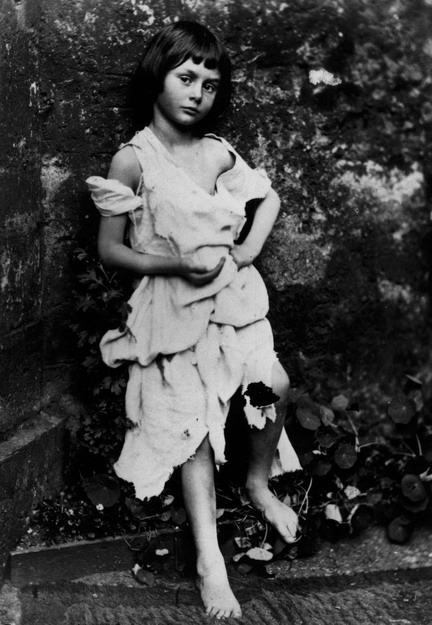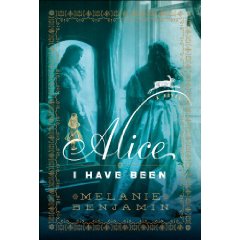Arthur in Wonderland: NPR reviewer messes up Carroll's name
 Wednesday, January 27, 2010 at 05:39PM
Wednesday, January 27, 2010 at 05:39PM When Maureen Corrigan, the main book reviewer for NPR's Fresh Air show,  The Beggar-Maid by Lewis Carroll, photograph in the collection of Princeton Universityreviewed Alice I Have Been, she revealed that she's not as meticulous or as sharp as I thought she was. The book she reviewed, by Melanie Benjamin, is poorly written and not carefully researched. Corrigan praised the book and assumed that Benjamin wrote an historically accurate book -- which she did not. If Corrigan had done just a little research, she could have learned about the real Lewis Carroll. Corrigan -- who generally is a good book reviewer -- fumbles so badly that she calls Lewis Carroll by the name Arthur Carroll. (Initially, the transcript of the book review on the Fresh Air website even misspelled Corrigan's first name.)
The Beggar-Maid by Lewis Carroll, photograph in the collection of Princeton Universityreviewed Alice I Have Been, she revealed that she's not as meticulous or as sharp as I thought she was. The book she reviewed, by Melanie Benjamin, is poorly written and not carefully researched. Corrigan praised the book and assumed that Benjamin wrote an historically accurate book -- which she did not. If Corrigan had done just a little research, she could have learned about the real Lewis Carroll. Corrigan -- who generally is a good book reviewer -- fumbles so badly that she calls Lewis Carroll by the name Arthur Carroll. (Initially, the transcript of the book review on the Fresh Air website even misspelled Corrigan's first name.)
I find it fustrating when poorly written books -- fiction or criticism -- get recognition. Actually Melanie Benjamin is a pen name and the author's name is Melanie Hauser. I think that is the most clever aspect of this novel, since Lewis Carroll is the pen name of Charles Lutwidge Dodgson. Besides reading her book, I also read a profile of the author by Julia Keller in the Chicago Tribune as Benjamin lives in the Chicago area (17 January 2010).
What struck me was Benjamin's limited knowledge of Lewis Carroll. She wandered into Chicago's Art Institute sometime between October 2003 and January 2004 and "discovered" the traveling show of Lewis Carroll photographs, which was based on Douglas Nickel's Dreaming in Pictures: The Photography of Lewis Carroll (2002). Nickel's book is not particularly good scholarship. The exhibition, which I also saw, was okay. There are far better books on Carroll's photography -- including Roger Taylor and Edward Wakeling's Lewis Carroll Photographer: The Princeton University Library Albums (2002), Morton Cohen's Reflection in a Looking-Glass: A Centennial Celebration of Lewis Carroll, Photographer (1998), Anne Higonnet's Lewis Carroll (2008), and even Helmut Gersheim's groundbreaking Lewis Carroll: Photographer (1949). This is to point out that bad novels are often built on poor scholarship.
So in 2003, Benjamin "discovers" that Lewis Caroll actually took photographs (!) of little girls (!!) and that there was a real child who was the inspiration for the protagonist of the Alice books (!!!). Oh my gosh. Stop the presses -- have we got a story to tell. To quote Benjamin, from the Chicago Tribune feature, "I didn't know there had been a real girl named Alice." Imagine Benjamin's surprise when she discovered that there are at least two book-length biographies of Alice Liddell: Anne Clark's The Real Alice: Lewis Carroll's Dreamchild (1981) and Colin Gordon's Beyond the Looking Glass: Reflections of Alice and Her Family (1982). If readers want to "discover" the true of Alice Liddell, I would encourage them to read either of these books rather than Alice I Have Been. They contain a great deal more accurate information about Alice Liddell, are better written and full of wonderful illustrations. It seems that Benjamin is just a bit behind the learning curve in terms of Carroll studies. (For more on Carroll studies, check out the websites of the U.S. and U.K. Carroll societies)
It reminds me of when my wife was teaching a college course on popular culture and James Cameron's 1997 film Titanic was released. After seeing the film, some of her students indignantly remarked, "Why didn't anyone tell us about the Titanic?!" Frankly, I don't believe there was much of an international conspiracy to keep people from knowing about the sinking of the Titanic or that Lewis Carroll was a noted photographer of children and considered, by most scholars, to be, along with Julia Margaret Cameron, one of the two best photographers of children in the nineteenth century. But all of this seems to be news to Benjamin when she wandered into the Art Institute.
What seems ironic and telling about Alice I Have Been is that Benjamin was inspired to write the novel as the result of her "discovering" the photography of Lewis Carroll at the Art Institute. But the novel's cover features a photograph that was not taken by Lewis Carroll, but another Victorian photographer, Clementina, Viscountess Hawarden. The photograh is Hararden's "Clementina before a mirror," and features the photographer's own daughter. If you want to read about a somewhat creepy Victorian photographer, forget Carroll and read about Hawarden. I good place to start is Carol Mavor's Becoming: The Photographs of Clementina, Viscountess Hawarden (1999).
the result of her "discovering" the photography of Lewis Carroll at the Art Institute. But the novel's cover features a photograph that was not taken by Lewis Carroll, but another Victorian photographer, Clementina, Viscountess Hawarden. The photograh is Hararden's "Clementina before a mirror," and features the photographer's own daughter. If you want to read about a somewhat creepy Victorian photographer, forget Carroll and read about Hawarden. I good place to start is Carol Mavor's Becoming: The Photographs of Clementina, Viscountess Hawarden (1999).
The other disappointing aspect of the novel is that it follows, or repeats, much of the plot of Gavin Millar's 1985 film Dreamchild, in which Alice Liddell is an old woman who looks back and reflects on her relationship with Carroll. So it seems that Benjamin was unfamiliar with Carroll's photography and Dreamchild.
If authors wants to write historical fiction, they ought to know history. Alice I Have Been wants to re-invent the wheel and does it rather poorly. It frankly reads like a rush job that was intended to cash in on the release of Tim Burton's film adaptation of Alice in Wonderland. Actually Benjamin acknowledges this in the Tribune feature.
Maureen Corrigan's mess up on Lewis Carroll's name reminds me of that infamous anti-drug tract Go Ask Alice (1971). It was touted to be an actual teen diary, but turned out to be written by Beatrice Sparks, a Mormon youth counselor, who misidentified the author of the Alice books as "Lewis G. Carroll" and wrote, " I feel like Alice in Wonderland. Maybe Lewis G. Carroll was on drugs too."
Just as Go Ask Alice was a poorly written and deceptive novel, and I feel the same is the case with Benjamin's Alice I Have Been. But that doesn't seem to stop them from becoming popular. Unfortunately, this is how myths and distortions concerning Lewis Carroll are promoted. Facts are replaced by fiction and then assumed to be accurate.
I would prefer that readers interested in Lewis Carroll read Morton Cohen's Lewis Carroll: A Biography (1995), the standard, for a more accurate portrait of Carroll's life. They might even want to read my recent book, The Place of Lewis Carroll in Children's Literature (2009), which includes the chapter, "The Beggar-Maid: Alice Liddell as Street Arab." In it, I examine in detail Carroll's most famous photograph of Alice Liddell. I think some readers might enjoy discovering that the facts of Lewis Carroll's life are as interesting as the myths.
While I am reluctant to draw unnecessary attention to Alice I Have Been, I do want to let interested readers know that it is far from original, sometimes distorts the facts, and there are a number of excellent books about Alice Liddell, Lewis Carroll, and his photography published prior to Alice I Have Been that will provide a more accurate understanding of these subjects. The best aspect of the inaccurate historical book is that it may direct some readers to Carroll's Alice books and his photography. I hope that is the case.
By the way, Happy birthday to Lewis Carrol today!
